How to Make GLP-1 Naturally: Boosting Your Body’s Hormonal Balance

Introduction
Did you know that a simple change in your diet can significantly enhance your body’s production of a crucial hormone known as glucagon-like peptide-1 (GLP-1)? This hormone is not just a buzzword in the health and wellness community; it plays a vital role in regulating blood sugar levels, managing appetite, and even promoting weight loss. As healthcare professionals increasingly highlight GLP-1’s importance, many of us are left wondering: how can we naturally boost GLP-1 levels without relying solely on medications?
At TrimRx, we believe that sustainable weight loss and overall health should be achieved through science, empathy, and an individualized approach. In this blog post, we will explore how to make GLP-1 naturally by focusing on diet and lifestyle choices that can support your body’s natural processes. We aim to provide you with actionable insights and practical advice that you can incorporate into your daily routine, helping you embark on a healthier journey.
Throughout this article, we will cover the role of GLP-1, how it functions in the body, and a variety of natural strategies to enhance its production. We will also discuss the types of foods that can increase GLP-1 levels, the impact of exercise, and the significance of a balanced diet. By the end of this post, you will have a comprehensive understanding of how dietary choices and lifestyle adjustments can empower you to boost your GLP-1 levels naturally, promoting better health and well-being.
Let’s dive into the science of GLP-1 and discover the factors that can help you harness its benefits for your health.
Understanding GLP-1
To effectively make GLP-1 naturally, it’s essential to first understand what it is and why it matters. GLP-1 is a hormone produced in the intestines that plays a key role in glucose metabolism and appetite regulation. When we eat, GLP-1 is released, signaling the pancreas to secrete insulin, which helps lower blood sugar levels. Additionally, GLP-1 inhibits the release of glucagon, a hormone that raises blood sugar, and slows gastric emptying, promoting a feeling of fullness.
The Importance of GLP-1
The significance of GLP-1 extends beyond blood sugar regulation. Here are a few critical functions of GLP-1:
- Appetite Control: GLP-1 helps to curb appetite, making you feel fuller for longer periods.
- Weight Management: By regulating both insulin and glucagon, GLP-1 plays a pivotal role in weight loss and management.
- Cardiovascular Health: Emerging research suggests that GLP-1 may have protective effects on cardiovascular health.
Given these benefits, it’s no surprise that GLP-1 has become a focal point in the fields of obesity and diabetes management. While medications like semaglutide (Ozempic, Wegovy) and tirzepatide (Mounjaro, Zepbound) mimic GLP-1’s effects, we can also promote its natural production through dietary and lifestyle changes.
Dietary Strategies to Enhance GLP-1 Levels
1. Focus on Protein
Protein is an essential macronutrient that can significantly influence GLP-1 secretion. Foods rich in protein, such as lean meats, fish, eggs, and legumes, are known to stimulate the release of GLP-1. For instance, eggs, particularly egg whites, have been shown to enhance GLP-1 levels. A study found that participants consuming eggs for breakfast experienced lower post-meal blood glucose levels and reduced hunger compared to those who ate a bagel breakfast.
Actionable Tip: Incorporate high-quality protein sources into your meals. Consider starting your day with eggs or adding legumes to salads and soups.
2. Embrace Healthy Fats
Not all fats are created equal, and healthy fats, particularly monounsaturated fats, can positively impact GLP-1 levels. Foods like avocados, olive oil, and nuts are excellent sources of these beneficial fats. Research has indicated that a Mediterranean diet rich in olive oil can lead to higher GLP-1 levels and improved insulin sensitivity.
Actionable Tip: Incorporate sources of healthy fats into your meals. Drizzle olive oil on your salads, add avocado to your toast, or snack on a handful of nuts.
3. Increase Fiber Intake
Fiber is a powerhouse when it comes to enhancing GLP-1 secretion. Foods high in soluble fiber, such as oats, barley, and legumes, can slow digestion and promote a gradual release of glucose into the bloodstream. This slow release triggers the gut to produce more GLP-1. Moreover, the fermentation of fiber by gut bacteria produces short-chain fatty acids (SCFAs), which are known to stimulate GLP-1 release.
Actionable Tip: Include a variety of fiber-rich foods in your diet, such as whole grains, fruits, and vegetables. Start your day with oatmeal topped with fruits or add beans to your meals for an extra fiber boost.
4. Choose Low Glycemic Index Foods
The glycemic index (GI) measures how quickly foods raise blood sugar levels. Low GI foods, such as whole grains, legumes, fruits, and non-starchy vegetables, are digested slowly, resulting in a gradual increase in blood sugar and a corresponding increase in GLP-1 release. These foods help maintain stable blood sugar levels and can reduce hunger pangs.
Actionable Tip: Focus on low GI foods as staples in your meals. Choose quinoa, sweet potatoes, and legumes over white rice and bread.
5. Incorporate Vegetables
Vegetables are not only nutrient-dense but also rich in fiber, making them excellent for boosting GLP-1 levels. Cruciferous vegetables, such as broccoli and Brussels sprouts, are particularly beneficial due to their high fiber content and vitamins. A study indicated that consuming vegetables before carbohydrate-rich meals significantly affected glucose and GLP-1 levels, especially in individuals with type 2 diabetes.
Actionable Tip: Fill half your plate with vegetables at every meal. Experiment with different cooking methods, such as roasting or steaming, to enhance their flavor and appeal.
The Role of Exercise in GLP-1 Production
While dietary choices play a significant role in GLP-1 production, physical activity is equally important. Regular exercise has been shown to increase GLP-1 levels, improving insulin sensitivity and overall metabolic health.
1. Aerobic Exercise
Engaging in moderate-intensity aerobic exercise, such as brisk walking or cycling, can enhance GLP-1 levels. Research shows that both a single exercise session and long-term training positively influence GLP-1 secretion, particularly in individuals with type 2 diabetes.
Actionable Tip: Aim for at least 150 minutes of moderate-intensity aerobic exercise each week. Consider joining a local walking group or participating in cycling classes to stay motivated.
2. Resistance Training
Incorporating resistance training into your fitness routine can also benefit GLP-1 levels. Building muscle mass increases your body’s metabolic rate and can help regulate hormones more effectively.
Actionable Tip: Include strength training exercises at least twice a week. Bodyweight exercises, resistance bands, or weightlifting are great options to get started.
Lifestyle Factors that Influence GLP-1
1. Sleep Quality
Sleep plays a critical role in hormonal regulation, including GLP-1 production. Poor sleep quality can lead to hormonal imbalances, including reduced GLP-1 levels, which can affect appetite and glucose metabolism.
Actionable Tip: Prioritize good sleep hygiene by establishing a consistent sleep schedule, creating a comfortable sleep environment, and minimizing screen time before bed.
2. Stress Management
Chronic stress can negatively impact GLP-1 secretion, leading to increased cravings and weight gain. Stress hormones can interfere with the body’s ability to produce GLP-1 effectively.
Actionable Tip: Incorporate stress-reducing activities into your daily routine. Practices such as mindfulness meditation, yoga, or deep-breathing exercises can help manage stress levels.
3. Hydration
Staying adequately hydrated is essential for overall health and can influence metabolic processes, including GLP-1 secretion. Dehydration may impair the body’s ability to respond to food intake.
Actionable Tip: Aim to drink enough water throughout the day. Consider carrying a reusable water bottle to remind yourself to stay hydrated.
Summary of Key Points
- GLP-1 is a crucial hormone for regulating blood sugar and appetite.
- Dietary choices, including protein, healthy fats, fiber, and low GI foods, can enhance GLP-1 levels.
- Regular exercise, including both aerobic and resistance training, supports GLP-1 production.
- Lifestyle factors such as sleep quality, stress management, and hydration also play a role in GLP-1 secretion.
Conclusion
Boosting GLP-1 levels naturally is an attainable goal that can significantly impact your overall health and well-being. By focusing on a balanced diet rich in proteins, healthy fats, and fiber, along with regular physical activity and healthy lifestyle choices, we can harness the power of this essential hormone to support weight management and metabolic health.
At TrimRx, we are committed to helping individuals embrace healthier lifestyles through personalized, medically supervised care. If you’re interested in exploring how our tailored weight loss programs can support your journey, we invite you to take our free assessment quiz to determine your eligibility for our prescription weight loss medications. Together, we’ll work towards a healthier you.
Additionally, consider supporting your weight loss journey with our quick-access supplements. Our GLP-1 Daily Support and Weight Loss Boost can provide valuable assistance as you work to enhance your health naturally.
FAQ
What is GLP-1 and why is it important?
GLP-1 is a hormone produced in the intestines that regulates blood sugar levels, appetite, and digestion. It plays a crucial role in helping the body manage glucose and maintain a feeling of fullness.
How can I naturally increase my GLP-1 levels?
To boost GLP-1 naturally, focus on a diet rich in protein, healthy fats, and fiber. Incorporate regular exercise, prioritize sleep quality, manage stress, and stay hydrated.
Are there specific foods that enhance GLP-1 secretion?
Yes! Foods high in protein (such as eggs and lean meats), healthy fats (like avocados and olive oil), and fiber (such as whole grains and vegetables) can promote GLP-1 secretion.
What role does exercise play in GLP-1 production?
Regular physical activity, including aerobic exercise and resistance training, has been shown to enhance GLP-1 levels and improve insulin sensitivity.
Can I take supplements to increase GLP-1?
While some supplements claim to boost GLP-1, it’s essential to consult with a healthcare provider. A balanced diet and healthy lifestyle choices are more effective and safer ways to support GLP-1 production.

Transforming Lives, One Step at a Time
Keep reading
7 Tips for Sticking to GLP-1 Injection Schedules
Seven practical strategies to keep weekly GLP‑1 injections on schedule—pick a routine day, set reminders, manage side effects, rotate sites, and avoid missed doses.
Custom GLP-1 Dosing for Kidney Disease
Personalized GLP-1 dosing for CKD patients with monitoring, dehydration and hypoglycemia risk mitigation, and guidance across all kidney disease stages.
Semaglutide vs Tirzepatide: Approved Uses
Two leading diabetes and weight-loss drugs differ in FDA-approved benefits — one adds heart, kidney and liver protection; the other treats obstructive sleep apnea.



